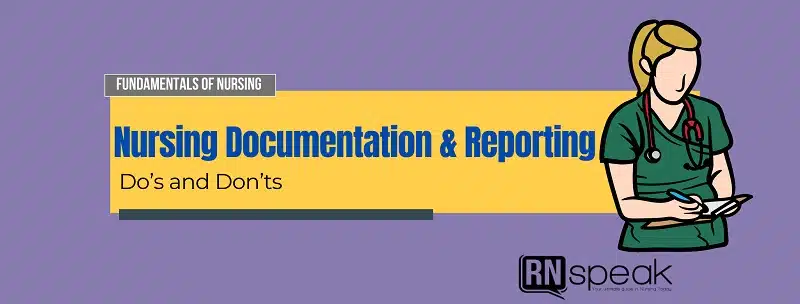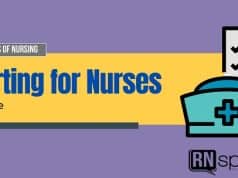Nursing documentation refers to the written evidence that reflects a nurse’s actions and responsibilities, providing a permanent lega record of patient care. It includes detailed information about assessments, interventions, patient responses, and changes in condition. On the other hand, nursing reporting involves the oral or written exchange of information among healthcare team members at the end of a shift or during patient handovers. Reporting focuses on communicating essential patient information, such as changes in condition, care plans, and critical updates, to ensure continuity of care and collaboration among healthcare professionals.
What are the functions of the patient’s chart?
1. Communication
It serves as a well-organized process of relaying necessary information from one care provider to another. It imparts important data about the patient’s condition.
2. Legal Documentation
It will serve as legitimate evidence used even in court.
3. Research
The health information provided can be the basis for ongoing and future research.
4. Statistics
It can be used as statistical data for health-related planning.
5. Education
Health science students can utilize the facts for educational purposes.
6. Review and Quality Assurance
The record can be utilized to assess the healthcare quality provided to the patient and the competency of the healthcare provider.
7. Preparation of Patient’s Care
The chart can be the source of information for the whole healthcare team to plan the patient’s care.
Types of Nurse Records
• Traditional Patient Record
The different individuals or departments involved in the patient’s care have allocated sections in the chart.
Parts:
Admission Sheet
Doctor’s Order Sheet
Medical History
Nurse’s Notes
Other important reports and records ( laboratory findings, vital signs sheet, input and output sheet, referrals)
• Problem-Related Patient Record
The patient’s information is documented and organized in accordance with the origin of the data. The chart incorporates all the information regarding the problem as identified by the healthcare team.
Elements:
Database
List of Problems
Preliminary Plan of Care
Progress Notes
Nurse’s notes (SOAPIE of FDAR format)
Flow Sheets
Discharge Notes and Referral Summary
• Kardex
It is an organized and concise sheet regarding the patient’s information and care used during endorsements. It is available to all the healthcare providers involved in the patient’s care.
Components:
Demographic or personal information
Basic needs
Allergies
Laboratory tests
Daily nursing procedures
Medications, intravenous fluids, and blood transfusions
Other treatments like suctioning, mechanical ventilation, oxygen therapy, or dressing change
Types of Nursing Reports
• End of Shift Reporting or Endorsement
It is mainly done for continuity of care. Aside from the information stated in the Kardex, other important data regarding the patient’s care is also endorsed to the receiving team.
• Telephone Reports
Telephone reports are usually brief and clear. This information should be included:
Date and time call was made
The name of the person who made the call
The receiver of the call
The receiver of the information
The data are given
The data received
• Telephone Order
Registered nurses are the only ones who can receive and process telephone orders. Telephone orders are validated by relaying the information clearly and accurately. This kind of order should be countersigned by the doctor who gave the order in no more than 24 hours.
• Transfer Report
This type of reporting is done when a patient is transferred from one department to another.
Importance of Nursing Documentation and Reporting
See Also: 10 Best Practices on How to Produce an Accurate Nursing Documentation
Documentation and reporting are critical aspects of nursing practice for several key reasons:
Communication and Continuity of Care
Nursing documentation communicates important clinical information about a patient’s health status and care to the entire healthcare team. It ensures continuity of care by providing a record of assessments, treatments, and patient responses. Clear documentation allows nurses to pick up where others left off and maintain a comprehensive picture of the patient’s condition.
Patient Safety and Quality Improvement
Accurate, timely documentation helps prevent medical errors and ensures patients receive safe, high-quality care. It provides evidence of the care provided and protects against liability. Reviewing documentation records can also provide insights for quality improvement initiatives.
Legal and Ethical Obligations
Nurses have a legal obligation to document patient care according to professional standards and facility policies. Documentation serves as evidence in legal proceedings and protects nurses’ licenses. Adhering to ethical guidelines, such as maintaining patient privacy, is also important.
Research and Population Health
Nursing documentation provides data for research to advance the nursing profession and improve healthcare overall. Analyzing patient records can yield insights into population health trends and needs.
To ensure effective documentation, nurses should prioritize accuracy, avoid late entries, maintain legibility, use standard abbreviations, chart symptoms, and treatments, avoid opinions, and follow best practices. Proper documentation is a critical part of providing safe, high-quality, and ethical patient care.
The Do’s and Don’t’s in Nursing Documentation
In the world of healthcare, nursing documentation and reporting play an important role in ensuring quality patient care. By accurately recording and communicating information, nurses can enhance patient safety, improve continuity of care, and facilitate effective interdisciplinary collaboration. However, practicing the main principles of documentation and reporting can be complex. Let’s explore the do’s and don’ts in nursing documentation and reporting to help nurses excel in this essential aspect of their practice.
The Do’s:
Do Document Promptly and Accurately
Timely and precise documentation is vital for maintaining the continuity of care and ensuring patient safety. Record information as soon as possible after an event to capture details accurately.
Be specific when writing data.
Example:
Correct: Consumed 2 Liters of water.
Incorrect: Drank plenty of water.
In addition, use proper punctuation marks to quote the patient’s statement. Behaviors are also noted instead of the patient’s feelings.
Examples:
“I feel a stabbing pain in the center of my chest.”
It is also important to include objective data.
Temp.=38.1ْ˚,PR=101bpm,RR=28bpm,BP=140/80mmHg, diaphoretic, skin warm to touch.
Do Use Clear and Concise Language
Avoid medical jargon and acronyms that may be confusing to others. Use simple, understandable language to convey information effectively.
Do Proper Usage of Ink
Use a ballpoint pen when writing any information on the chart. Avoid using a felt pen or pencil.
Do Follow Organizational Policies and Standards
Adhere to your facility’s documentation guidelines to maintain consistency and compliance with legal and regulatory requirements.
Do Include Relevant Information
Document all assessments, interventions, patient responses, and changes in condition. Ensure that your documentation is comprehensive and reflects the patient’s status accurately.
Do Avoid Errors
In case of an error, place a horizontal line over the wrong data. After this, place the word “error” on top of the mistake and affix the healthcare provider’s signature.
Example:
ERROR CM
BP=130/90mmHg
Do Maintain Confidentiality
Respect patient privacy by ensuring that all documentation is secure and only accessible to authorized individuals. Follow HIPAA guidelines to protect patient information.
Do Communicate Effectively
Use documentation as a tool for communication among healthcare team members. Share important information, updates, and concerns to promote collaboration and continuity of care.
The Don’ts
Don’t Alter or Delete Entries
Avoid making changes to documentation after the fact. If an error is made, follow your facility’s correction policy to ensure transparency and accuracy.
Don’t Make Assumptions
Document only what you observe and what is reported to you. Avoid speculating or making assumptions in your documentation to maintain objectivity and accuracy.
Don’t Use Abbreviations Carelessly
While abbreviations can save time, they can also lead to misinterpretation. Use approved abbreviations and avoid creating your own to prevent confusion.
Here are the following standard terminologies you can use:
| Abbreviation | Latin | English |
| a.c. | ante cebum | Before meals |
| ad.lib. | ad libitum | As desired |
| ADL | Activities of daily living | |
| ax. | Axillary | |
| bid | bis in die | Twice a day |
| BMR | Basal metabolic rate | |
| BP | Blood pressure | |
| c.c. | cum | With |
| cap | capsula | Capsule |
| gtt | gutta | Drop |
| h.s. | hora omni | Hours of sleep |
| IM | Intramuscular | |
| IV | Intravenous | |
| mcgtt | Microdrop | |
|
Once a day | |
| OD |
|
Right eye |
|
Every morning | |
| OS |
|
left eye |
| OU |
|
Both eyes |
| p.c. | post cebum | After meals |
| p.o. | per orem | By mouth |
| p.r.n. | pro re nata | As necessary |
| q.h. | quaque hora | Every hour |
| q.i.d. | quarter in die | Four times a day |
| s.s. | sine | Without |
| s.c. | sub cutem | Subcutaneously |
| ss. | semis | One-half |
| stat | statim | Immediately |
| tid | ter in die | Three times a day |
Don’t Delay Documentation
Procrastination can lead to inaccuracies and omissions. Document promptly to capture details while they are fresh in your mind.
Don’t Skip Documentation
Every interaction, assessment, and intervention should be documented. Omitting information can lead to gaps in care and compromise patient safety.
Don’t Document for Others
Each nurse is responsible for their own documentation. Avoid signing or documenting for someone else, as this can lead to legal and ethical issues.
By following these do’s and don’ts in nursing documentation and reporting, nurses can improve the quality of care they provide, enhance patient safety, and facilitate effective interdisciplinary communication. Remember, accurate and timely documentation is not just a task; it’s a crucial part of nursing practice that significantly impacts patient outcomes and healthcare delivery.
References
- Quiambao-Udan,J.(2004). Mastering Fundamentals of Nursing. (2nd Ed.). Educational Publishing House.
- Documentation in Nursing: 1st Canadian edition. Retrieved May 23, 2024, from Torontomu.ca website: https://pressbooks.library.torontomu.ca/documentation/chapter/reasons-for-documentation/
- Hughes, Suzanne. (2012). Kozier and Erb’s Fundamentals of Nursing: Concepts, Process and Practice. Nurse Education in Practice. 12. e12. 10.1016/j.nepr.2011.09.002.
- Tips for great nursing documentation. (2019, August 20). Retrieved May 23, 2024, from Rivier Academics website: https://www.rivier.edu/academics/blog-posts/tips-for-great-nursing-documentation/






![FDAR Charting for Nurses [5 Tips for Effective FDAR Charting & Common Mistakes to Avoid] Fdar charting](https://rnspeak.com/wp-content/uploads/2023/06/Fdar-charting-238x178.jpg)

